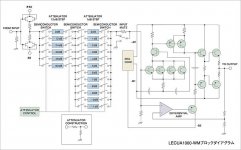Hi everybody...
a little bit of a basic question here...
what do they mean by :
The Luxman L-590Ax builds upon renowned L-590A II and improves on it especially with the new LECUA 1000WM attenuator (the LECUA stands for Luxman Electric Controlled Ultimate Attenuator and the WM stands for Weighting Matrix) and the circuitry that has been adopted from Luxman´s flagship C-1000f control amplifier and B-1000f mono power amplifier. Luxman claims the LECUA 1000WM to be the ´ultimate attenuator´ that aspires to be the first absolutely lossless attenuator ever. It converts the music signal from a voltage into a current, controls gain, and then reconverts the current into a voltage. A position of the volume knob is detected by sensors to be consequently evaluated by processor board that controls the current switches combinations. As the LECUA does not imply any impedance changes there is no deterioration of S/N ratio and frequency response remains totally uniform and there is virtually zero tracking difference between both channels. The entire process is carried out in analog domain including electrical suppression of RFI and EMI interferences.
would it be better than a Alps RK50 per exemple ?
or any stepped attenuator ?
sorry for this basic question ; help greatly appreciated 🙂😉😉😉😉
thanks
P
a little bit of a basic question here...
what do they mean by :
The Luxman L-590Ax builds upon renowned L-590A II and improves on it especially with the new LECUA 1000WM attenuator (the LECUA stands for Luxman Electric Controlled Ultimate Attenuator and the WM stands for Weighting Matrix) and the circuitry that has been adopted from Luxman´s flagship C-1000f control amplifier and B-1000f mono power amplifier. Luxman claims the LECUA 1000WM to be the ´ultimate attenuator´ that aspires to be the first absolutely lossless attenuator ever. It converts the music signal from a voltage into a current, controls gain, and then reconverts the current into a voltage. A position of the volume knob is detected by sensors to be consequently evaluated by processor board that controls the current switches combinations. As the LECUA does not imply any impedance changes there is no deterioration of S/N ratio and frequency response remains totally uniform and there is virtually zero tracking difference between both channels. The entire process is carried out in analog domain including electrical suppression of RFI and EMI interferences.
would it be better than a Alps RK50 per exemple ?
or any stepped attenuator ?
sorry for this basic question ; help greatly appreciated 🙂😉😉😉😉
thanks
P
would it be better than a Alps RK50 per exemple ?
P
?????????????????????????????????????????????????????????????????????????
"The LECUA 1000WM circuit converts the music signal from a voltage into a current, switches gain by means of switching on the attentuaes, and then reconverts the current into a voltage. The entire process is carried out in the analog domain."
??????????????????????????????????????????????????????????????????????????
Cheers George
sorry for the ultra basic question...
but i was not acccurate enough probably...
i was wondering DESIGN AND SOUND wise if that is the "best" solution to use in a preamp....
thanks
P
but i was not acccurate enough probably...
i was wondering DESIGN AND SOUND wise if that is the "best" solution to use in a preamp....
thanks
P
This looks like a simple buffered ladder attenuator. There was a mention at 6moons that the signal passes through 2 resistors at any given volume setting. Whether there is any form of V/I and I/V i cannot say from the meager info, but quite possibly controlling the gain in the current domain is a better idea when dealing with relatively high Ron switching elements. Nothing at all revolutionary.
In the end, as with most other things it's all down to the specific implementation. Per example - the type of resistors. Saw no mention of z-foils but maybe they are just being modest 🙂
In the end, as with most other things it's all down to the specific implementation. Per example - the type of resistors. Saw no mention of z-foils but maybe they are just being modest 🙂
Attachments
One DIY implementation is my MDAC attenuator. Details here:
http://www.diyaudio.com/forums/anal...or-using-analog-switches-multiplying-dac.html
Measurement in this post:
http://www.diyaudio.com/forums/anal...log-switches-multiplying-dac.html#post3815926
I really like the design, I'm still using mine every day. I am also designing a newer version for a new preamp.
bbp also made version but with separate analog switches instead of using a R2R DAC IC:
http://www.diyaudio.com/forums/vend...control-module-ultimate-attenuator-audio.html
He also posted excellent measurements.
http://www.diyaudio.com/forums/anal...or-using-analog-switches-multiplying-dac.html
Measurement in this post:
http://www.diyaudio.com/forums/anal...log-switches-multiplying-dac.html#post3815926
I really like the design, I'm still using mine every day. I am also designing a newer version for a new preamp.
bbp also made version but with separate analog switches instead of using a R2R DAC IC:
http://www.diyaudio.com/forums/vend...control-module-ultimate-attenuator-audio.html
He also posted excellent measurements.
- Status
- Not open for further replies.
- Home
- Source & Line
- Analog Line Level
- LECUA 1000 attenuator from Luxman ?
